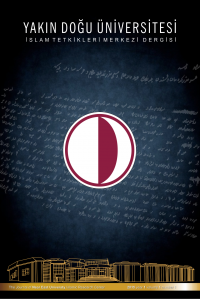Safevî Döneminin Bazı Cami ve Medreselerinde Şer'i Öğlen Vaktini Belirleyen Uygulamaların İncelemesi
Müslüman sanatçılar, tarih boyunca kültürel ve dini yapılarını tasarlarken, toplumun ihtiyaçlarına cevap verecek bilimsel çözümler sunmuşlardır. Müslüman bilim insanları ve sanatçılar, özellikle Müslümanların vaktinde dinî görevlerini yerine getirebilmeleri için, ilme ve tabiata uygun olan çözümler üretmişlerdir. Bu bilimsel çözümlerden biri de güneşin konumuna bağlı olan namaz ve şer'i vakitleri tayin etmek için teknikler uygulanması ve bunun için aletler icat edilmesidir. Bu makalede, Safevî Dönemi'ne ait bazı cami ve medreselerdeki şer'i öğlen vaktini belirleyen uygulamalar incelenmiştir. Ulaşılan sonuçlara göre, söz konusu uygulamalar üç gruba ayrılabilmektedir. Birinci grupta yer alanlar, taşınır olarak cami ve medrese binasından ayrıdır. İkinci grupta yer alanlar ise, cami ve medrese binasına eklenmiş olup, bu yapılarda kullanılan malzemelerle uyuşamayan, dekorasyon elemanları olarak kabul edilmeyen unsurlardan ibarettir. Üçüncü grup ise, cami ve medreselerde kullanılan malzemelere uyumlu olmasına rağmen, dekorasyon elemanları olarak kabul edilmeyenleri kapsamaktadır. Bu gruptakilerin dekoratif işlevleri yoktur ve sadece şer'i vakitler ve kıble yönünü belirtmek için kullanılmıştır.
Anahtar Kelimeler:
Mimari, Şer'i Öğlen, Cami, Medrese, Safevi Dönemi
The Survey of the Practices Determining Zuhr Prayer Time in Some of the Safavid Mosques and Madrasas
Throughout history, Muslim artists have offered scientific solutions to meet the needs of society while designing their cultural and religious structures. Muslim scientists and artists have produced solutions that are compatible with science and nature, especially for Muslims to fulfil their religious duties on time. One of these scientific solutions is the application of techniques to determine the prayer and religious times depending on the position of the sun and the invention of tools for this. In this article, the practices determining the Zuhr prayer time (Zuhr time) in some mosques and madrasas belonging to the Safavid Period are examined. According to the results, these applications can be divided into three groups. Those in the first group are movably separate from the mosque and the madrasa building. Those in the second group are added to the mosque and madrasa building and consist of elements that do not match the materials used in these structures and are not considered decoration elements. The third group includes those that are not considered as decoration elements, although they are compatible with the materials used in mosques and madrasas. Those in this group have no decorative function and are only used to indicate the religious times and the direction of qibla.
Keywords:
Architecture, Zuhr Prayer Time, Mosque, Madrasa, Safavid Era,
___
- al-Mustaufi al-Qazwini, Hamdullah, Nuzhatu-l-qulub, Researcher: Mohammad Dabir Siyaghi, Hadis Emruz, Qazvin, 2002.
- al-Jahiz, Abu Usman Umar bin Bahr, Kitab al-Hayawan, edited by Muhammad Basil Uyun al-Sud, Dar ul-Kitab el-ilmiyeh, Beirut, 1429.
- Beig Babapour, Yousef, Bibliography of Manuscripts of Astronomy and Related Sciences (available in libraries of Iran and some countries of the world), Volume 2, Armaghan, Tehran, 2015.
- Chardin, Jean, Chardin Travelogue, translated by Mohammad Abbasi, Amirkabir, Tehran, 1956.
- Curzon, George Nathaniel, Persia and the Persian Question, Translated by: Vahid Mazandarani, Vol. 2, Elmi Farhangi Publication, Tehran, 1971.
- Dehkhoda, Ali Akbar, Dictionary, Vol. 2&13, University of Tehran Press, Tehran, 1998.
- Delavaleh, Pietro, Pietro Delavaleh's Travelogue, Translated by Mahmoud Behforuz, Qatreh, Tehran, 2001.
- Gelen, William & Morten, Henry, The Bible, Old and New Testaments, Translated by: Fazel Khan Hamedani, 1st Edition, Asatir Publications, Tehran, 2001.
- Group Author, Encyclopedia of the Islamic World, Vol. 5, Islamic Encyclopedia Foundation, Tehran, 2000.
- Hassanzadeh Amoli, Hassan, “Building the Mosque of Medina and Determining the Qibla”, Keyhan Andisheh, 63 (December and January 1995), s. 76.
- Hill, Donald and Ahmad, Yousef Hassan, Illustrated History of Islamic Technology, translated by Nasser Movafaghian, Scientific and Cultural Publications, Tehran, 1996.
- Hillenbrand, Robert, Islamic Art and Architecture, Translated by: Ardeshir Eshraqi, Farhangestan Honar Publications, Tehran, 2008.
- Javid Khalili, Niloufar, “Educated Ancestors: Baha'al-din al-'Amili”, Month Book of the Science and Technology, 105 (September 2008), s. 15.
- Javadi, Asiye, Iranian Architecture, 1st Edition, Mojerred Publication, Tehran, 1984.
- Javadi Najafi, Seyed Mohammad Akbar, "Indian Circle and its Application", Meshkat, 15 (Summer 1987), s. 87 & 90.
- King, David, “What of Science in The Service of Religion?”, Translated by: Tawfiq Haidarzadeh, Farhang, 20-21 (Winter 1996 and Spring 1997), s. 198-200 & 204-210.
- Mashkouriyan, Mohammad Taqi, Study and Analyzing of Chronological System's Components of Safavid Iran Society, PhD Thesis, University of Isfahan, History of Islamic Iran, Supervisor: Ali Akbar Jafari, Asghar Foroughi Abri, 1395.
- Naji-Nasrabadi, Mohsen, Shaykh Baha'i: Bibliography, Astan Quds Razavi; Islamic Research Foundation, Mashhad, 2008, p. 643.
- Rad, Ahmad, "What time is it?", Yaghma, 173 (December 1962), s. 402-403.
- Qaedan, Asghar, History and Works of Islam of Makkah and Medina, 2st Edition, Mash'ar Publication, Tehran, 2003.
- Tahanavi, Mohammad ibn Ali, Kashaf Istilahat al-funun wa-al-'ulum, Librairie Du Liban Publishers, Beirut, 1996.
- Varjavand, Parviz, Exploring the Maragheh Observatory and a Look at the Background of Astronomical Knowledge in Iran, Amirkabir Publications, Tehran, 2006.
- Zakeri, Mustafa, "Najm Al-Dawla's Two Textbooks on Geography and Science", Nameh Anjoman, 18 (Summer 2005), s. 103.
- Zaka, Yahya, "Iranian Research: Nowruz and its Astronomical Foundation", Ayandeh, 7/6 (September 1981), s. 425-427.
- Zamani Ghomshei, Ali, Islamic Astronomy, Volume 4, Imam Sadegh Institute, Qom, 2008.
- ISSN: 2148-922X
- Başlangıç: 2015
- Yayıncı: Yakın Doğu Üniversitesi
Sayıdaki Diğer Makaleler
Muhyiddin İbn Arabî ve Abdulhak İbn Seb‘in’in Vahdet Anlayışlarının Mukayesesi
Kitab-ı Mukaddes ve Kur’an’a Göre İnsan
Osmanlı İktisat Tasavvuru ve Modernleşme: 19. Yüzyıldan Portreler-Olaylar-Belgeler
Safevî Döneminin Bazı Cami ve Medreselerinde Şer'i Öğlen Vaktini Belirleyen Uygulamaların İncelemesi
Klasik Arap Şiirinde Yerilen Kötü Bir Ahlak: Mal/Servet Biriktirmek
